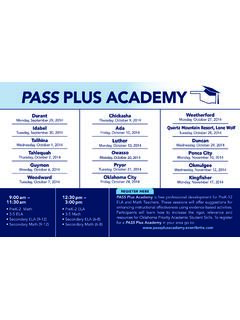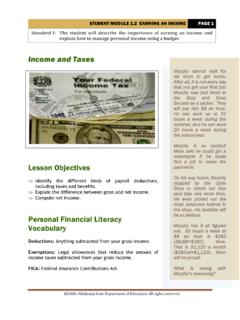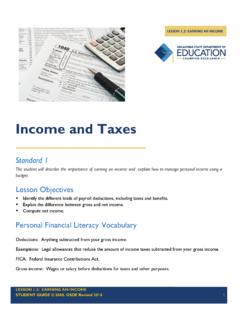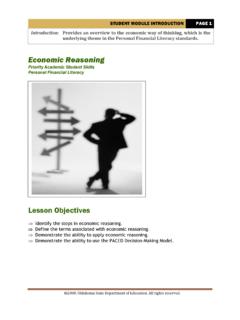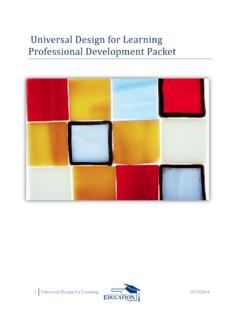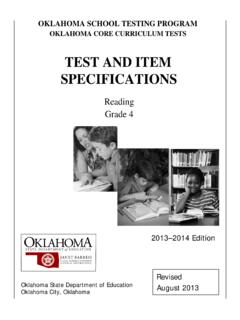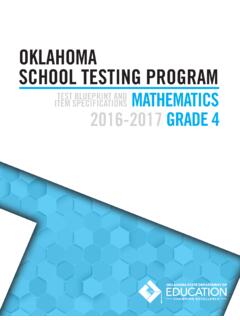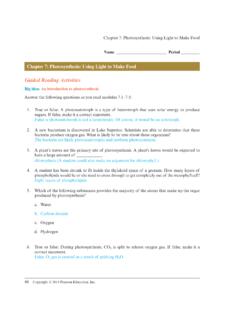Transcription of Kindergarten Developmental Checklist
1 Janet Barresi, State Superintendent of Public Instruction Kindergarten Developmental Checklist Kindergarten Developmental Checklist Child _____ Date of Birth _____. Teacher _____ School _____. This Checklist was developed fr om the Kindergarten Oklahom a Priority Academic Student Skills to assist and guide teachers in observing and recording what children can do. For further clarification on specific students skills, consult the Oklah oma Priority Academic Student Skills for Kindergarten . The evaluation periods are indicated by the numbers 1, 2, 3, and 4. The following ratings can be used: Not Applicable (NA) Skill or behavior has not been introduced.
2 Not Yet (N) Child cannot demonstrate skill or behavior at this time. In Progress (P) Child demonstrates skill or behavior intermittently. Consistent (C) Child can consistently demonstrate skill or behavior with proficiency. Example: 1 2 3 4. 1. Works and plays cooperatively in a variety of settings. NA P PC. Social Skills 1. Works and plays cooperatively in a variety of settings. 2. Demonstrates an understanding of school and classroom guidelines. 3. Listens to others while in large and small groups. 4. Stays involved in a self-selected activity for an appropriate length of time (approximately 15 to 20 minutes). 5. Follows simple verbal directions.
3 6. Works independently and/or cooperatively to solve problems. 7. Selects and completes a task while working at a learning center. 8. Chooses a variety of materials and activities from learning centers. 9. Recognizes dangerous situations and takes action to protect self ( , uses telephone, knows safety rules). 10. Attends to personal tasks. Comments: _____. _____. _____. May 2007 1. Creative Skills 1. Expresses thoughts and ideas about work or play. 2. Develops and verbalizes solutions to simple problems. 3. Thinks of new uses for familiar materials. Comments: _____. _____. _____. Language Arts 1. Completes simple rhyming pairs.
4 2. Hears and repeats sounds in a sequence. 3. Hears and repeats a simple eight to ten word sentence. 4. Tells what happens first, middle, and last about an event or activity. 5. Dictates a story about an event or experience. 6. Answers questions and contributes ideas that are relevant to the conversation or group discussion. 7. Speaks using complete sentences that include a subject, verb, simple phrases, and some adjectives. 8. Tells what is happening in a picture. 9. Identifies and reads first and last name in print. 10. Reproduces a three-object pattern from memory ( , {). 11. Identifies and names eight basic colors (black, blue, red, yellow, orange, green, brown, purple ).}
5 12. Matches at least half of the upper-case letters with the lower-case letters. May 2007 2. Language Arts 13. Uses some initial and ending consonant sounds. 14. Names some letters of the alphabet. 15. Recognizes, names, and matches some words in context. 16. Reads his or her own writing to the group, teacher, and/or parent(s). 17. Demonstrates left-to-right and top-to-bottom eye movement when engaged in appropriate activities. 18. Shows basic parts of a book (front and back), holds book correctly, and indicates where to begin reading. 19. Prints first and last name on unlined paper. 20. Traces, copies, and generates shapes, letters, and numerals.
6 Comments: _____. _____. Mathematics 1. Identifies, names, and draws a circle, square, rectangle, and triangle when shown an example. 2. Identifies some three-dimensional objects. 3. Sorts objects, groups into sets, and tells what the objects have in common. 4. Builds groups or sets that have more than, less than, and equivalent quantities, and tells which have more or less. 5. Pairs and counts objects using one-to-one correspondence ( , one napkin for each child at snack time). 6. States numbers in sequential order from one to twenty. 7. Counts objects in a set, one-by-one, from zero through ten. 8. Constructs, identifies, and names sets of objects zero through ten.
7 May 2007 3. Mathematics 9. Identifies and names numerals zero through ten (0, 1, 2, 3, 4, 5, 6, 7, 8, 9, 10) in and out of sequence. 10. Matches sets of objects to numerals zero through ten. 11. Points to objects and names their ordinal position first through fifth. 12. Writes numerals zero to ten, in and out of sequence, on unlined paper. 13. Identifies and names sizes such as big, bigger, biggest; small, smaller, smallest; and small, medium, large. 14. Identifies and names lengths such as long, longer, longest; or short, shorter, shortest. 15. Puts objects in graduated order from shortest to tallest, or thinnest to thickest. 16.
8 Identifies and names a penny, nickel, dime, and quarter. 17. Helps create and explain a simple graph, such as a bar graph showing how many boys and girls are in the class. 18. Demonstrates (with objects) spatially related terms such as on, above, below, beside, under, on top of, behind, and over. 19. Identifies the days of the week and months of the year. Comments: _____. _____. _____. Motor Skills 1. Demonstrates basic locomotor movements such as walking, running, jumping, hopping, galloping, and skipping. 2. Demonstrates nonlocomotor movements such as bending, stretching, pulling, and pushing. 3. Balances on one foot for approximately five seconds.
9 4. Walks and balances on a four-inch line or balance beam. May 2007 4. Motor Skills 5. Coordinates large arm movements such as easel painting, woodworking, and climbing. 6. Demonstrates strengthened hand and eye coordination when working with pegs; stringing beads; using pattern blocks; using crayons, pencils, paint brushes, and fingerpaint on plain paper; cutting with scissors; using glue; and fitting a variety of puzzles. 7. Holds and uses pencils, crayons, or markers using a three finger grasp. Comments: _____. _____. _____. Science 1. Observes and describes characteristics of the four seasons such as temperature, weather, and appropriate clothing.
10 2. Observes and describes characteristics of weather using vocabulary such as sun, rainbow, clouds, fog, shadows, dew, frost, rain, hail, sleet, snow, lightning, thunder, temperature, and tornado. 3. Observes and describes what various plants and animals need for growth. 4. Observes, describes, and classifies the sensory attributes of objects according to taste, smell, hearing, touch, and sight. 5. Observes, describes, and classifies real objects according to their common properties. 6. States the opposite properties of some objects, such as magnetic-nonmagnetic, float-sink, heavy-light, rough-smooth, hard-soft, solid-liquid, and wet-dry.
